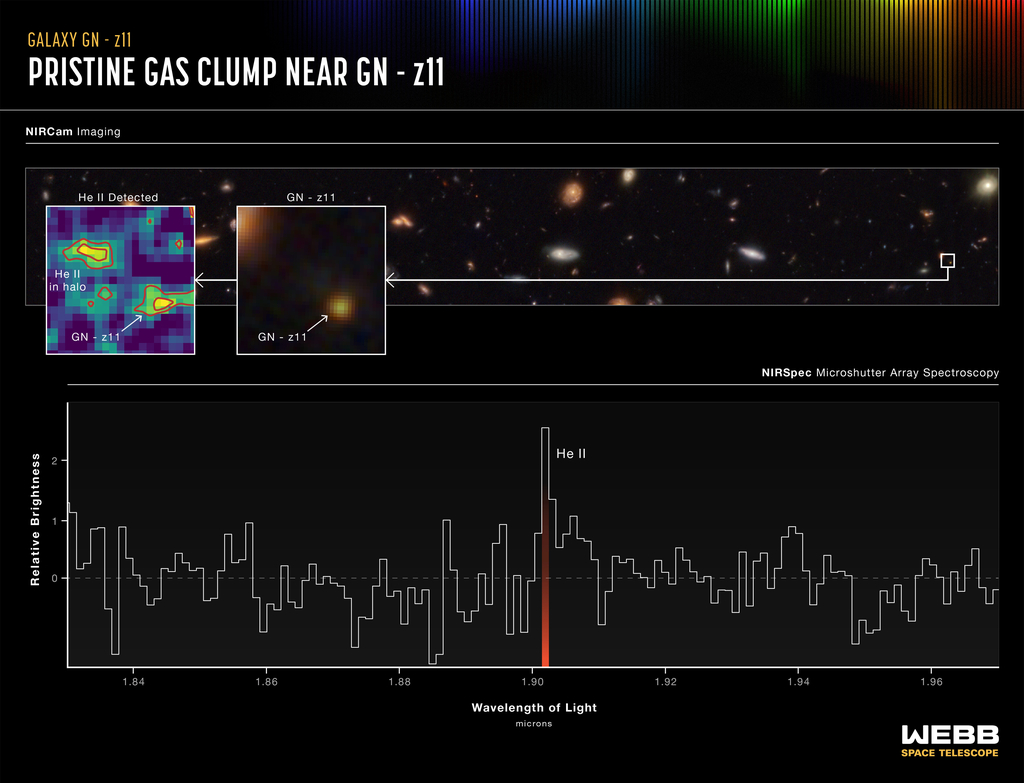Secrets revealed from observations of very distant galaxy

Two teams have studied the extremely bright and young galaxy GN-z11, existing when the universe was only around 430 million years old. The initial detection was made using NASA’s Hubble Space Telescope, becoming one of the youngest and most distant galaxy ever observed which led scientists to question its luminosity.
Using NASA’s James Webb Space Telescope a team found the first clear evidence of a supermassive black hole at the centre of the galaxy which is rapidly accreting matter, making it the farthest supermassive black hole yet. “We found extremely dense gas that is common in the vicinity of supermassive black holes accreting gas,” explained principal investigator Roberto Maiolino of the Cavendish Laboratory and the Kavli Institute of Cosmology at the University of Cambridge in the United Kingdom. “These were the first clear signatures that GN-z11 is hosting a black hole that is gobbling matter.”
Additionally, the team found signs of ionised chemical elements which are commonly observed near accreting supermassive black holes. An exceptionally powerful wind was also being released from the galaxy. Such fast winds are typically driven by processes associated with rapidly accreting supermassive black holes. “Webb’s NIRCam (Near-Infrared Camera) has revealed an extended component, tracing the host galaxy, and a central, compact source whose colors are consistent with those of an accretion disk surrounding a black hole,” said investigator Hannah Übler, also of the Cavendish Laboratory and the Kavli Institute. Such observations are consistent with a 2 million solar mass supermassive black hole at the centre of GN-z11 in a very active phase of consuming matter, resulting in the high luminosity.

A second team, also led by Maiolino have used JWST’s NIRSpec, finding a gaseous clump of helium in the galactic halo of GN-z11. “The fact that we don't see anything else beyond helium suggests that this clump must be fairly pristine,” said Maiolino. “This is something that was expected by theory and simulations in the vicinity of particularly massive galaxies from these epochs — that there should be pockets of pristine gas surviving in the halo, and these may collapse and form Population III star clusters.”
Population III stars make up the first generation of stars in the universe, formed entirely from hydrogen and helium. The observation of such stars is one of the most crucial goals in modern astrophysics. Pop III stars are expected to be very massive, luminous and hot, with a signature of their presence in the form of ionised helium along with the absence of any heavier chemical elements. The formation of these stars marked a fundamental point in cosmic history, whereby the universe evolved from a dark and relatively simple state into the more complex and structured universe we see today.
The teams plan to carry out future observations using JWST, taking a closer look at GN-z11 which will hope to strengthen the case for Pop III stars which could be forming in the halo.
--
Cover image: NASA, ESA, CSA, B. Robertson (UC Santa Cruz), B. Johnson (CfA), S. Tacchella (Cambridge), M. Rieke (University of Arizona), D. Eisenstein (CfA)
Journal reference: Maiolino, R., Scholtz, J., Witstok, J. et al. A small and vigorous black hole in the early Universe. Nature (2024). https://doi.org/10.1038/s41586-024-07052-5
